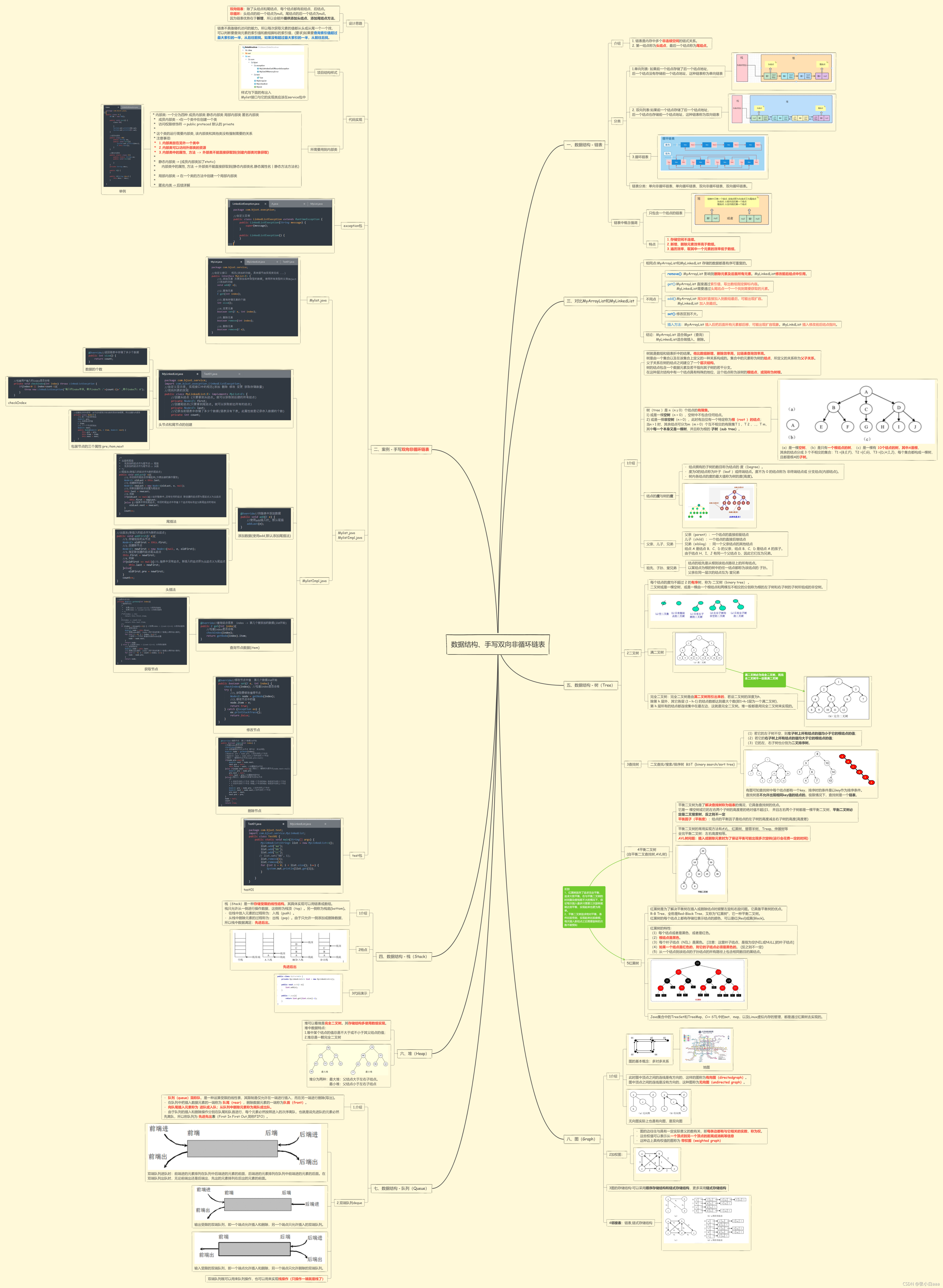- 数据结构-链表
- 简介与分类
- 特殊例子(只有一个节点)
- 特点
- 手写双向给循环链表(源码体现)
- 文案最下面附代码
- 对比MyArraylist和Mylinedlist
- 数据结构-栈(Stack)(后续笔记中会深入)
- 简介
- 特点
- 简要代码演示
- 数据结构-数(Tree)(要理解完全二叉数的含义哦(⊙o⊙))
- 简介
- 二叉树
- 查找树
- 平衡二叉树
- 红黑树
- 数据结构-堆(Heap)(后续笔记中会深入)
- 数据结构-队列
- 数据结构-图(Graph)
(如果大家没有对象,一定要new个对象哦!-------野猪行为)

- 手写双向给循环链表(源码体现)
- 异常包
?//自定义异常 public class LinkedListExecption extends RuntimeException { public LinkedListExecption(String message) { super(message); } public LinkedListExecption() { } } - MyList<E> 接口
//自定义接口 规范(添加的功能, 具体细节由实现类完成 ...) public interface MyList<E> { //1.添加元素 方便添加各种类型的数据, 使用所有类型的父类Object //添加的功能 void add(E e); //2.查询元素 E get(int index); //3.查询存储元素的个数 int size(); //4.变更元素 boolean set(E e, int index); //5.删除元素 boolean remove(int index); //6.删除元素 boolean remove(E e); } - MyLinkedList<E> 实现类
package com.bjsxt.service; import com.bjsxt.execption.LinkedListExecption; //自定义显示类, 实现接口中的规范(添加 删除 修改 变更 获取存储数量) //双向列表的实现 public class MyLinkedList<E> implements MyList<E> { //创建头结点 (只要拿到头结点, 就可以获取到后续的所有结点) private Node<E> first; //创建尾结点(只要拿到尾结点, 就可以获取前边所有的结点) private Node<E> last; //记录当前链表中存储了多少个数据(链表没有下表, 此属性就是记录存入数据的个数) private int count; @Override//查询结点信息 index -> 第几个被添加的数据(从0开始) public E get(int index){ //检查index是否合格 checkIndex(index); return getNode(index).item; } @Override//返回链表中存储了多少个数据 public int size() { return count; } //检查用户输入的index是否合格 private void checkIndex(int index) throws LinkedListExecption { if(index<0 || index>count-1){ throw new LinkedListExecption("输入的index有误, 最大index为 :"+(count-1)+" ,最小index为: 0"); } } //创建结点的内部类 此节点内部类只有当前的双向列表需要, 所以创建为内部类 private class Node<E>{ //1.前一个结点的地址 Node<E> pre; //2.当前结点的值 E item; //3.下一个节点的地址 Node<E> next; public Node(Node<E> pre, E item, Node<E> next) { this.pre = pre; this.item = item; this.next = next; } } /* * 头插和尾插 * 先添加的结点作为尾节点-> 尾插 * 先添加的结点作为尾节点-> 头插 * */ //尾插法(新插入的结点作为新的尾结点) public void addLast(E e){ //1.将目前的尾结点存储起来(方便后续的操作属性) Node<E> oldLast = this.last; //2.创建新的结点 Node<E> newLast = new Node<>(oldLast, e, null); //3.将新创建的结点设置为尾结点 this.last = newLast; //4.判断 if(oldLast == null){//此时链表中,没有任何的结点 新创建的结点即为尾结点又为头结点 this.first = newLast; }else {//链表中存在尾结点, 将旧的尾结点中存储下个结点地址改变为新尾结点的地址 oldLast.next = newLast; } count++; } //头插法(新插入的结点作为新的头结点) public void addFirst(E e){ //1.存储现在的头节点 Node<E> oldFirst = this.first; //2.创建新节点 Node<E> newFirst = new Node<>(null, e, oldFirst); //3.指定新创建的结点尾头结点 this.first = newFirst; //4.判断 if(oldFirst == null){//5.链表中没有结点, 新插入的结点即为头结点又为尾结点 this.last = newFirst; }else{ oldFirst.pre = newFirst; } count++; } @Override//向链表中添加数据 public void add(E e) { //使用add插入时, 默认尾插 addLast(e); } @Override//修改节点中值 第几个数据从0开始 public boolean set(E e, int index) { checkIndex(index); //检查index是否合格 try { //1.获取要修改值得节点 Node<E> node = getNode(index); //2.修改节点中的值 node.item = e; return true; } catch (Exception ex) { ex.printStackTrace(); return false; } } @Override//删除节点 第几个数据从0开始 public boolean remove(int index) { //检查index是否合格 checkIndex(index); //1.获取删除的节点(头节点 尾节点 非头非尾) Node<E> node = getNode(index); //Node<E> pre = node.pre; //该节点的上个节点 //Node<E> next = node.next;//该节点的下个节点 //情况一: 删除的为头节点(node.pre==null) if(node.pre==null){ Node<E> next = node.next; next.pre = null; this.first = next; //设置新的头节点 }else if(node.next==null){//情况二: 删除的为尾节点(node.next==null) Node<E> pre = node.pre; pre.next = null; this.last = pre;//设置新的尾节点 }else{//情况三: 删除的为非尾节点非头节点 /* * 1.将该节点的上个节点 存储下个节点的地址 改成该节点的下个节点 * 2.将该节点的下个节点 存储上个节点的地址 改成该节点的上个节点 * */ Node<E> pre = node.pre; //该节点的上个节点 Node<E> next = node.next;//该节点的下个节点 pre.next = next; next.pre = pre; } node = null; count--; return true; } //获取节点方法 private Node<E> getNode(int index){ //查询的优化 /* * 如果index < ((cout-1)>>1) 从前向后查询 * 如果index >= ((cout-1)>>1) 从向前后查询 * */ /*if(index == 0){ return this.first.item; } if(index == count-1){ return this.last.item; }*/ if (index < ((count)>>1)) { //如果index < ((cout-1)>>1) 从前向后查询 //1.获取头结点 Node<E> node = this.first; //2.根据index遍历 index->用户添加的第几个数据(从零开始计算的) for (int i = 0; i < index; i++) { //获取下一个节点 赋值给当前的node变量 node = node.next; } return node; } else { //如果index > ((cout-1)>>1) 从向前后查询 //1.获取尾结点 Node<E> node = this.last; //2.根据index遍历 index->用户添加的第几个数据(从零开始计算的) for (int i = 0; i < count-1-index; i++) { node = node.pre; } return node; } } }
- 异常包
- ?